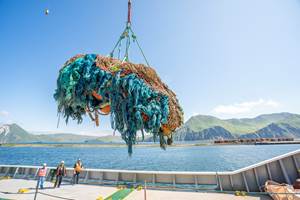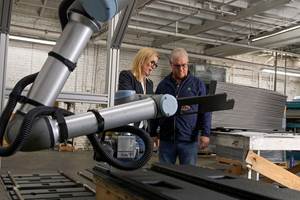Thermoforming Helps Harvest the Wind
It was a decades-old relationship that led to the development of an exciting new application for twin-sheet thermoforming.
Apparently it pays to be memorable in high school after all. It was a decades-old relationship between George Lawton, an engineer for Kintz Plastics, and a member of the design team at Optiwind that led to the development of an exciting new application for twin-sheet thermoforming: a cover for the vertical surfaces on Optiwind’s wind turbines.
Kintz Plastics Inc., in the upstate New York town of Howes Cave, has been an industry leader in thick-gauge thermoforming since it opened in 1976. The family-owned company uses vacuum forming, pressure forming, and twin-sheet forming to supply covers, bezels, and housings for applications ranging from biomedical equipment like blood-analysis machines to air-conditioned pet carriers to drainage and storm-water projects.
With annual sales in the range of $10 million to $15 million and more than 100 employees, Kintz’s plant includes a 30,000-ft² Technology Center that integrates design and engineering departments. The thermoformer’s 35 years of experience in materials, processing, part and tool design (Kintz guarantees its molds for the life of the project), painting, and screen printing, have helped it get involved in projects early in the design phase. Kintz’s ability to work with customers on a soup-to-nuts basis comes in handy when an altogether new project heads it way.
“We didn’t know Optiwind, nor about the possible application, until they came to us about 18 months ago,” recalls Wynn Kintz, CEO. “But one of their guys went to high school with George, and things progressed from there.”
The project has required several tooling iterations. The tool itself weighs more than a ton. “That whole process was a collaborative effort between their team of designers and our engineering/design group,” states Kintz. “Lots of meetings, lots of drawings, lots of modifications, none of which is surprising on a new application.”
The part is made up of numerous HDPE cones that are formed into the sheet. The complete part stands 66 in. wide x 105 in. tall, representing one of the largest Kintz has produced. The parts are formed on rotary thermoformers from Maac Machinery Corp., Carol Stream, Ill. “There aren’t many thermoformers capable of producing a part this complicated and this large,” Kintz says. “The sheet is only 0.062-in. thick, and the window to get all the different parts to bond is very narrow.”
The Optiwind turbines themselves are a shade under 200-ft tall and require a cover that is lightweight but strong enough to withstand wind and weather. “Twin-sheet thermoforming was key to the design of the wind turbine,” says David Hurwitt, marketing v.p. for Optiwind in Torrington, Conn.
The Optiwind turbines are designed for mid-size applications, such as schools, hotels, retailers, farms, and municipalities. They are said to be more compact and quieter than traditional turbine designs and are built right on the site of the energy consumer. The first test turbine with the Kintz cover was installed at a farm in Torrington last year. A full-scale commercial launch is planned for 2011.
Kintz expects to produce thousands of parts a year for the project (roughly 250 parts go into each turbine). The covers are interchangeable on Optiwind turbines of different sizes.
Related Content
Manufacturer Helps Clean Up Global Waterways with Reclaimed Plastics
RSP and Oceanworks partnership diverts plastic wastes from waterways for incorporation into new products.
Read MoreThermoforming PCR: An Equipment Supplier’s Pointers
Thermoforming PCR is not radically different from forming virgin, but variation in recycled materials can require extra care to get a consistent end result. Start by examining every aspect of the process from the sheet (and extrusion process if run inline) to the final trim.
Read MoreNovel ‘Clamtainer’ Extends Thermoformer's Reach in Packaging
Uniquely secure latching expands applications for Jamestown Plastics’ patented clamshell package design.
Read MoreCobot Creates 'Cell Manufacturing Dream' for Thermoformer
Kal Plastics deploys Universal Robot trimming cobot for a fraction of the cost and lead time of a CNC machine, cuts trimming time nearly in half and reduces late shipments to under 1% — all while improving employee safety and growth opportunities.
Read MoreRead Next
Understanding Melting in Single-Screw Extruders
You can better visualize the melting process by “flipping” the observation point so that the barrel appears to be turning clockwise around a stationary screw.
Read MoreWhy (and What) You Need to Dry
Other than polyolefins, almost every other polymer exhibits some level of polarity and therefore can absorb a certain amount of moisture from the atmosphere. Here’s a look at some of these materials, and what needs to be done to dry them.
Read More












.png;maxWidth=300;quality=90)











